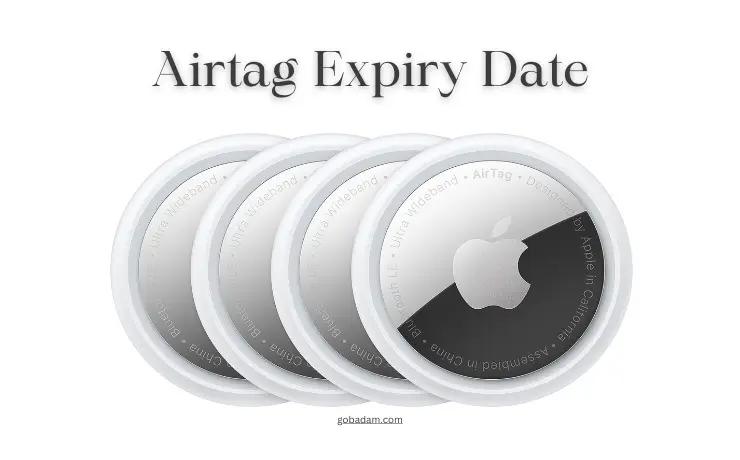Does Airtag have a lifespan? Ah, the million-dollar question on the lips of tech aficionados everywhere. Dive deep into the digital realm, and you’ll unearth fascinating nuances, from the Airtag’s impressive battery longevity to its sturdy design crafted for the modern adventurer. But that’s just scratching the surface.
SEE OFFER 👉🏻Apple Airtags
As an Airtag user, you might wonder about its software sustenance, or perhaps you’re playing the long game, pondering its warranty and post-life recycling protocols. Let’s embark on this electrifying journey to unravel the enigma that is the Airtag’s life cycle, shall we?
Does Airtag have a lifespan?
Yes, like all electronic devices, Airtags have a finite lifespan, primarily determined by their battery life and durability.
The Airtag is powered by a replaceable CR2032 coin cell battery, which Apple claims can last over a year under typical use. This means that when the battery depletes, users can simply replace it to continue using the Airtag. Durability-wise, while the Airtag is designed to be robust, its lifespan can be influenced by factors such as physical wear and tear, exposure to extreme conditions, or accidental damage.

Airtag Expiry Date
The lifespan of Apple’s AirTag, like all electronic devices, is influenced by several determining factors. One of the primary determinants is its battery life. Powered by a CR2032 coin cell battery, an AirTag boasts a duration of over a year under typical use. This longevity is further enhanced by the user’s ability to replace the battery, ensuring that the device remains functional far beyond its initial battery cycle.
However, durability plays an equally pivotal role. Even though AirTags are crafted for resilience, their longevity can be affected by regular wear and tear, especially if they’re continually on the move or exposed to extreme conditions.

Airtag Software Updates
Moving to the software realm, as technological advancements surge forward, there’s the looming possibility that Apple might phase out software support for older devices, including the AirTag. While this doesn’t render the device non-functional, it means the AirTag might miss out on newer features or crucial security updates.
One cannot ignore the broader perspective of hardware obsolescence. With the rapid pace of technological innovation, there might come a day when AirTag’s technology simply doesn’t hold up to newer, more advanced iterations, or when surrounding tech ecosystems evolve to a point where they no longer sync seamlessly with older devices.
Thus, while the AirTag is a marvel in its current context, it’s essential to remember that its relevance, like all tech products, is bound by the evolving tapestry of technology and time.
Airtag Battery Life
The AirTag is equipped with a CR2032 coin cell battery. Under typical usage conditions, Apple claims this battery can last over a year. The device is designed to notify the user when the battery is running low, ensuring they’re aware it’s time for a replacement.

Airtag Durability
Apple’s AirTag is crafted to be durable and robust. Its design is resistant to common everyday encounters, such as minor falls, scrapes, or jostles. However, it isn’t entirely waterproof or immune to significant impacts. While it can handle occasional splashes or rain, submerging it in water or exposing it to extreme conditions might compromise its functionality.
Airtag Performance Over Time
As with most electronic devices, the AirTag’s performance might show slight changes over extended use. While its tracking capabilities and connectivity with Apple devices remain consistent, factors like battery depletion or potential software updates might influence its responsiveness or feature set. Regularly updating its software and ensuring battery health can help maintain optimal performance.
How to prolong Airtag lifespan?
Here some tips to ensure your AirTag lasts longer:
- Regular Battery Replacement: Change the battery when notified to maintain optimal performance.
- Protect from Extreme Conditions: Avoid exposing the AirTag to very high or low temperatures, or submerging it in water.
- Software Updates: Regularly update your associated Apple device and ensure the AirTag software is up-to-date to benefit from patches or improvements.
- Use Protective Cases: Consider using protective cases or covers to shield it from physical damage.
Airtag’s Warranty and Service Life
Apple provides a limited one-year warranty for the AirTag from the date of purchase. This warranty covers manufacturing defects but doesn’t include damage from accidents or unauthorized modifications. If a defect arises within this period, Apple may offer to repair, replace, or refund the device. Extended warranty and support might be available through AppleCare.

Replacing Airtag Battery
Replacing the AirTag’s battery is a straightforward process:
- Press and Twist: Hold the AirTag with the stainless steel side facing down. Gently press on the cover and twist it counter-clockwise.
- Remove the Old Battery: Once the cover is off, take out the depleted CR2032 battery.
- Insert the New Battery: Place a new CR2032 battery in the compartment with the positive side facing up.
- Secure the Cover: Align the cover’s notches and twist it clockwise until it clicks into place.
SEE OFFER 👉🏻 Airtag battery replacement
Remember, regularly replacing the battery ensures the AirTag functions effectively and prolongs its operational life.
How to store Airtag properly?
Storing your AirTag properly can help ensure its longevity and maintain its functionality. Here’s a guide on how to store your AirTag correctly:
- Avoid Extreme Temperatures: Store your AirTag in a cool, dry place. Avoid leaving it in places with extreme temperatures, like inside a car on a hot day or in freezing conditions.
- Keep Away from Direct Sunlight: Prolonged exposure to direct sunlight can harm the internal components and the external finish of the AirTag.
- Protect from Moisture: While the AirTag is splash, water, and dust resistant to some degree, it’s not entirely waterproof. Ensure it’s not stored in damp or humid environments to avoid internal damage.
SEE OFFER 👉🏻Waterproof Airtag Holder
- Use a Protective Case: If you’re storing your AirTag for an extended period, consider placing it in a protective case. This shields it from dust, potential scratches, or other environmental factors.
SEE OFFER 👉🏻Airtag case keychain
- Avoid Electromagnetic Interference: Store your AirTag away from devices or areas with strong electromagnetic fields. While it’s designed to withstand typical electromagnetic environments, it’s always a good idea to avoid unnecessary exposure.
- Store Away from Children and Pets: Given its small size, the AirTag could be a choking hazard. Ensure it’s stored in a place inaccessible to young children or pets.
- Battery Consideration: If you’re planning to store the AirTag without using it for an extended period, consider removing the battery. This can prevent potential battery leakage or corrosion.
- Keep in Original Packaging: If you still have the original packaging, it can serve as a suitable storage option, offering protection from many environmental factors.
By following these storage guidelines, you can ensure that your AirTag remains in optimal condition, ready for use whenever you need it.
If you are interested in whether electronic products go bad or not you can take a look at can a surge protector fail as well.

Frequently Asked Questions About Does Airtag Have a Lifespan
Here you can find top questions about whether an Apple Airtag has a lifespan and how to prolong it. Also, there are more Q&A about this smart tracking device.
How should I store my AirTag to ensure longevity?
Store your AirTag in a cool, dry place, away from direct sunlight and extreme temperatures. If storing for extended periods, consider removing the battery to prevent potential leakage or corrosion.
Can I leave my AirTag in the car?
While the AirTag can withstand varying conditions, it’s best not to leave it in a car, especially on hot days or in freezing conditions, as extreme temperatures can impact its functionality.
Is the AirTag waterproof? Can I store it in damp places?
The AirTag is splash, water, and dust resistant, but not entirely waterproof. It’s advisable to avoid storing it in damp or humid environments to prevent internal damage.
Do I need a protective case for storing my AirTag?
While a protective case isn’t mandatory, using one can shield your AirTag from potential scratches, dust, and other environmental factors, especially if stored for longer durations. You can see offers for Airtag cases.
Will electromagnetic fields affect my stored AirTag?
AirTags are designed to withstand typical electromagnetic environments. However, to ensure optimal functionality, store them away from strong electromagnetic fields or devices that produce them.
Is it safe to keep my AirTag near my other electronic devices?
Yes, storing your AirTag near other electronic devices shouldn’t pose an issue. Just ensure it’s away from strong electromagnetic sources to avoid interference.
How long can I store my AirTag without using it?
You can store your AirTag for extended periods. If planning to do so, consider removing the battery to prevent potential leakage and ensuring it’s stored in optimal conditions.
Can the battery corrode if I store my AirTag for too long?
Yes, like most batteries, the CR2032 coin cell battery in the AirTag can corrode over time, especially if exposed to moisture or adverse conditions. If storing your AirTag for an extended period, it’s advisable to remove the battery.
In wrapping up our discussion on the lifespan of the Airtag, it’s intriguing to ponder the longevity of other items we use daily. After all, everything has a shelf life, whether it’s cutting-edge tech or more familiar household items. Ever thought about whether lava lamps go bad? Or questioned if surge protectors lose their edge over time? These are interesting questions worth exploring. If you’re curious like me, dive into these articles: Do lava lamps go bad, and Can surge protectors go bad? They provide insightful perspectives on the expected lifespan and functionality of various common items. Until next time, stay informed and keep questioning!


